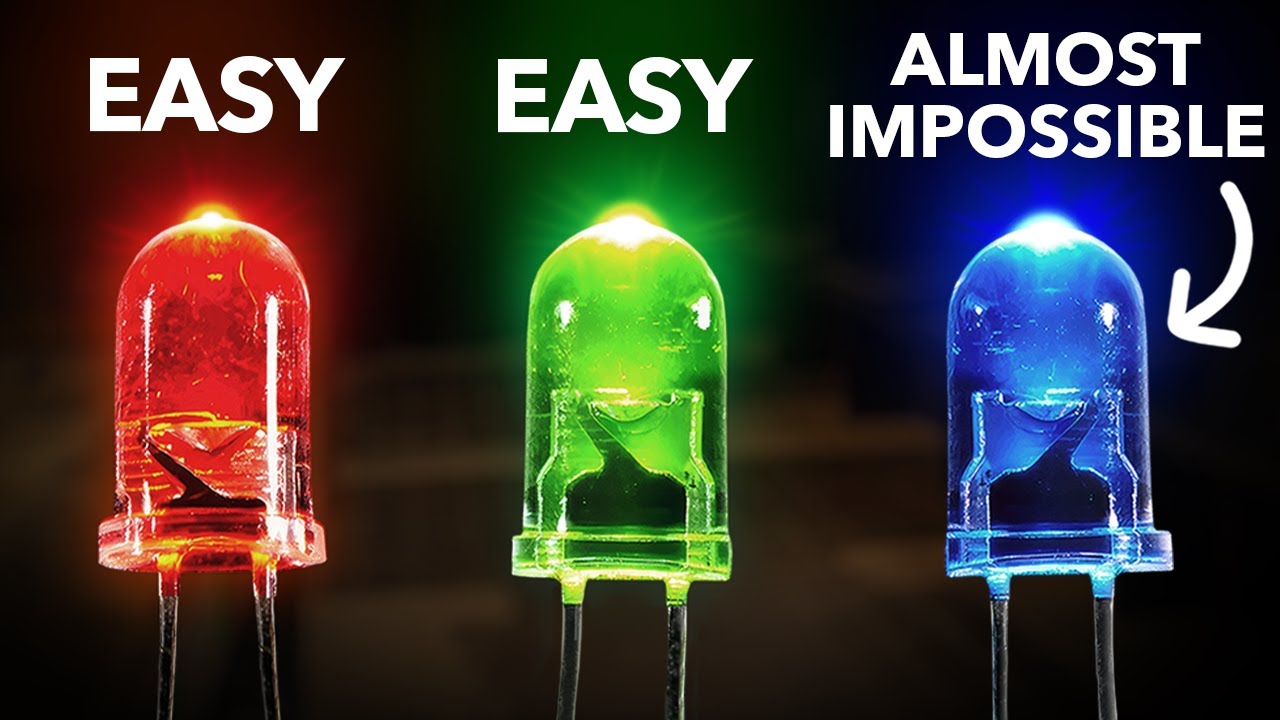The blue LED was supposed to be impossible—until a young engineer proposed a moonshot idea. Head to https://brilliant.org/veritasium to start your free 30-day trial, and the first 200 people get 20% off an annual premium subscription.
If you’re looking for a molecular modeling kit, try Snatoms, a kit I invented where the atoms snap together magnetically - https://ve42.co/SnatomsV
Huge thanks to the UC Santa Barbara Materials Dept (https://ssleec.ucsb.edu/) for taking us around.
Thanks to Álvaro Bermejillo Seco for reviewing the science.
Thanks to these especially helpful sources:
Nobel Prize Biography - Shuji Nakamura - https://ve42.co/NakamuraNobel
Johnstone, B. (2015). Brilliant!. Prometheus Books. - https://ve42.co/Johnstone2015
Nakamura, S., Pearton, S., & Fasol, G. (2010). The Blue Laser Diode: The Complete Story. Springer. - https://ve42.co/Nakamura2010
▀▀▀
References:
https://www.youtube.com/watch?v=O8M2z2hIbag
https://www.youtube.com/watch?v=TGUteH93xNo
https://www.youtube.com/watch?v=idwKHQEw78g
https://www.youtube.com/watch?v=yoTALRhAqWc
Touchstone, L. A. (2022). Nick Holonyak Jr. University of Illinois. - https://ve42.co/Touchstone2022
Perry, T. S. (1995). The Unsung Inventor. IEEE Spectrum. - https://ve42.co/Perry1995
Chabay, R. & Sherwood, B. (2011). Matter & interactions (4th ed.), S2: Semiconductors. Wiley. - https://ve42.co/ChabaySherwood
How MOCVD Works via Aixtron - https://ve42.co/MOCVD
Vangala, S. R., et al. (2019). Epitaxial growth of ZnSe on GaAs. Journal of Crystal Growth. - https://ve42.co/Vangala2019
Nakamura, S. (1991). GaN Growth Using GaN Buffer Layer. JJAP. - https://ve42.co/Nakamura3rd1991
Amano, H., et al. (1989). P-Type Conduction in Mg-Doped GaN w/ LEEBI. JJAP. - https://ve42.co/Amano1989
Huang, M., et al. (2021). Defects in Mg–H‐Codoped GaN. Physica Status Solidi. - https://ve42.co/Huang2021
Schubert, E. F. (2006). Light Emitting Diodes, Ch 4: LED basics. Cambridge University Press. - https://ve42.co/RPI-LEDs
Kitada, C. (2001). Blue About Japan. Japan Inc. - https://ve42.co/Kitada2001
Whitaker, T. (2002). Nakamura loses Nichia patent battle. Optics.org. - https://ve42.co/NichiaSales3
Pirates Osaka. (2014). Nakamura awarded Nobel Prize in Physics. Hatena Blog. - https://ve42.co/NichiaSales1
Growth Bozu via Twitter. - https://ve42.co/NichiaSales2
Rose, J. (2014). Blue LEDs – Filling the world with new light. The Royal Swedish Academy of Sciences. - https://ve42.co/Rose2014
Pattison, P. M., et al. (2017). LED lighting efficacy. Comptes Rendus Physique. - https://ve42.co/Pattison2017
Electricity pricing via EIA - https://ve42.co/ElectricityPricing
Lane, K., et al. (2023). Lighting. IEA. - https://ve42.co/LightingIEA
LED Footprint via The Climate Group - https://ve42.co/ClimateGroupLED
Nichia’s History via Nichia - https://ve42.co/NichiaHistory
Shuji Nakamura via Wikipedia - https://ve42.co/NakamuraWiki
Images & Video:
Lighting the World via UCTVInsight on YouTube - https://ve42.co/UCTVep2 & https://ve42.co/UCTVep3
Palo Alto Times 1971 Article via Newspapers.com - https://ve42.co/Newspapers
Nick Holonyak, Jr. and the LED via UIUC on YouTube - https://ve42.co/HolonyakIllinois
The Original Blue LED via Science History Institute on YouTube - https://ve42.co/OGBlueLED
Maxfield, M. (2022). Compound Semiconductors. EE Journal. - https://ve42.co/Maxfield2022
M. Stutzmann, et al. (2001). Playing with Polarity. pss (b). - https://ve42.co/Stutzman2001
Isamu Akasaki in 1995 via Andrey Nikolaev on YouTube - https://ve42.co/AsakiNikolaev
Pioneer TX-610 Stereo Tuner via Ian Marino on YouTube - https://ve42.co/StereoMarino
Shuji Nakamura via EPO on YouTube - https://ve42.co/NakamuraEPO
Nichia Campus via Nichia on LinkedIn - https://ve42.co/NichiaHQ
Nichia via TDElektronik on YouTube - https://ve42.co/NichiaTDE
Violeds Sterilization of COVID-19 via Seoul Viosys - https://ve42.co/SterilizationUV
▀▀▀
Special thanks to our Patreon supporters:
Chris Harper, Max Paladino, Balkrishna Heroor, Adam Foreman, Orlando Bassotto, Tj Steyn, meg noah, KeyWestr, TTST, John H. Austin, Jr., john kiehl, Anton Ragin, Diffbot, Gnare,
Dave Kircher, Burt Humburg, Blake Byers, Evgeny Skvortsov, Meekay, Bill Linder, Paul Peijzel, Josh Hibschman, Juan Benet, David Johnston, Ubiquity Ventures, Richard Sundvall, Lee Redden, Stephen Wilcox, Marinus Kuivenhoven, Michael Krugman, Sam Lutfi
▀▀▀
Directed by Emily Zhang
Written by Emily Zhang, Ricky Nathvani, and Derek Muller
Edited by Trenton Oliver
Illustrated by Jakub Misiek
Animated by Fabio Albertelli, Mike Radjabov, David Szakaly, Ivy Tello, and Alondra Vitae
Filmed by Derek Muller, Raquel Nuno, and Trenton Oliver
Additional research by Gregor Čavlović
Produced by Emily Zhang, Han Evans, Gregor Čavlović, and Derek Muller
Thumbnail by Ren Hurley
Additional video/photos supplied by Getty Images and Pond5
Music from Epidemic Sound

